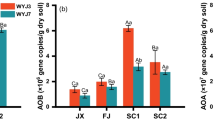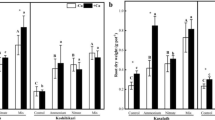Abstract
Clarifying the contribution of soil and fertilizer nitrogen (N) to rice N uptake is crucial to understand the synergistic mechanism of nitrification inhibitors (NI) and formulate the application strategy. Herein, four typical hydromorphic paddy soils, two origins with two soil fertilites for each origin, were selected for the pot experiment, with two treatments: (a) conventional split fertilization with 15 N-labeled urea and (b) combined with NI (2-chloro-6-(trichloromethyl)-pyridine (CP)). We found that CP addition significantly increased 16.92% rice yield and 19.86% N uptake than the control, which was not affected by soil type. The variables of inorganic N in paddy water, soil inorganic N, and soil microbial functional genes (AOA, AOB, nirK, nirS, and nosZ) explained together ~ 75% of the total variation between samples. Meaningfully, soil NOX−-N content at the heading stage and NOX−-N concentration in paddy water at tillering fertilization stage were the two most important contributors; the earlier contributed more (23.2%, P < 0.05) than the latter (18.4%, P < 0.05). As a result, the increased N uptake of CP treatment from urea (12.83%) was lower than that from soil (23.92%). Also, the soil bacterial community showed a definite response to CP addition. Proteobacteria, acidobacteria, and chloroflexi were the dominant bacteria in paddies for the tested soils at the phylum level, but their response to CP addition varied with soil type. The results confirm the increasing effect of NI on N utilization, and soils contribute more than urea. The response of soil bacterial community to CP addition also deserves attention.







Similar content being viewed by others
Data Availability
The datasets generated and analyzed during the current study are available from the corresponding author on reasonable request.
References
Anas M, Liao F, Verma KK, Sarwar MA, Mahmood A, Chen Z-L, Li Q, Zeng X-P, Liu Y, Li Y-R (2020) Fate of nitrogen in agriculture and environment: agronomic, eco-physiological and molecular approaches to improve nitrogen use efficiency. Biol Res 53:47. https://doi.org/10.1186/s40659-020-00312-4
Anderson CR, Peterson ME, Frampton RA, Bulman SR, Keenan S, Curtin D (2018) Rapid increases in soil pH solubilise organic matter, dramatically increase denitrification potential and strongly stimulate microorganisms from the Firmicutes phylum. PeerJ 6:e6090. https://doi.org/10.7717/peerj.6090
Aoyagi T, Inaba T, Aizawa H, Mayumi D, Sakata S, Charfi A, Suh C, Lee JH, Sato Y, Ogata A, Habe H, Hori T (2020) Unexpected diversity of acetate degraders in anaerobic membrane bioreactor treating organic solid waste revealed by high-sensitivity stable isotope probing. Water Res 176:115750. https://doi.org/10.1016/j.watres.2020.115750
Bao Y, Dolfing J, Guo Z, Chen R, Wu M, Li Z, Lin X, Feng Y (2021) Important ecophysiological roles of non-dominant Actinobacteria in plant residue decomposition, especially in less fertile soils. Microbiome 9:84. https://doi.org/10.1186/s40168-021-01032-x
Bronson KF, Hussain F, Pasuquin E, Ladha JK (2000) Use of 15N-labeled soil in measuring nitrogen fertilizer recovery efficiency in transplanted rice. Soil Sci Soc Am J 64:235–239. https://doi.org/10.2136/sssaj2000.641235x
Cassman KG, Dobermann A, Sta Cruz PC, Gines GC, Samson MI, Descalsota JP, Alcantara JM, Dizon MA, Olk DC (1996) Soil organic matter and the indigenous nitrogen supply of intensive irrigated rice systems in the tropics. Plant Soil 182:267–278. https://doi.org/10.1007/BF00029058
Erikstad H-A, Ceballos RM, Smestad NB, Birkeland N-K (2019) Global biogeographic distribution patterns of thermoacidophilic verrucomicrobia methanotrophs suggest allopatric evolution. Front Microbiol 10:1129. https://doi.org/10.3389/fmicb.2019.01129
Fageria NK, Baligar VC, Heinemann AB, Carvalho MCS (2015) Nitrogen uptake and use efficiency in rice. In: Rakshit A, Singh HB, Sen A (eds) Nutrient use efficiency: From basics to advances. Springer, New Delhi, pp 285–296
Feng Y, Xu Y, Yu Y, Xie Z, Lin X (2012) Mechanisms of biochar decreasing methane emission from Chinese paddy soils. Soil Biol Biochem 46:80–88. https://doi.org/10.1016/j.soilbio.2011.11.016
Feng Y, Sun H, Xue L, Liu Y, Gao Q, Lu K, Yang L (2017) Biochar applied at an appropriate rate can avoid increasing NH3 volatilization dramatically in rice paddy soil. Chemosphere 168:1277–1284. https://doi.org/10.1016/j.chemosphere.2016.11.151
Ferreira R, Gaspar H, Gonzalez JM, Clara MI, Santana MM (2015) Copper and temperature modify microbial communities, ammonium and sulfate release in soil. J Plant Nutr Soil Sci 178:953–962. https://doi.org/10.1002/jpln.201500318
Gaihre YK, Singh U, Bible WD, Fugice J, Sanabria J (2020) Mitigating N2O and NO emissions from direct-seeded rice with nitrification inhibitor and urea deep placement. Rice Sci 27:434–444. https://doi.org/10.1016/j.rsci.2020.03.005
Gioacchini P, Nastri A, Marzadori C, Giovannini C, Vittori Antisari L, Gessa C (2002) Influence of urease and nitrification inhibitors on N losses from soils fertilized with urea. Biol Fertil Soils 36:129–135. https://doi.org/10.1007/s00374-002-0521-1
Gu Y, Mi W, Xie Y, Ma Q, Wu L, Hu Z, Dai F (2019) Nitrapyrin affects the abundance of ammonia oxidizers rather than community structure in a yellow clay paddy soil. J Soils Sediments 19:872–882. https://doi.org/10.1007/s11368-018-2075-3
Han L, Chen L, Li D, Ji Y, Yuanyuan F, Yanfang F, Yang Z (2022) Influence of polyethylene terephthalate microplastic and biochar co-existence on paddy soil bacterial community structure and greenhouse gas emission. Environ Pollut 292:118386. https://doi.org/10.1016/j.envpol.2021.118386
He G, Liu X, Cui Z (2021) Achieving global food security by focusing on nitrogen efficiency potentials and local production. Glob Food Secur 29:100536. https://doi.org/10.1016/j.gfs.2021.100536
Hou P, Yuan W, Li G, Petropoulos E, Lixiang X, Feng Y, Lihong X, Yang L, Ding Y (2021) Deep fertilization with controlled-release fertilizer for higher cereal yield and N utilization in paddies: The optimal fertilization depth. Agron J 113:5027–5039. https://doi.org/10.1002/agj2.20772
Jumadi O, Hartono H, Masniawati A, Iriany RN, Makkulawu AT, Inubushi K (2019) Emissions of nitrous oxide and methane from rice field after granulated urea application with nitrification inhibitors and zeolite under different water managements. Paddy Water Environ 17:715–724. https://doi.org/10.1007/s10333-019-00724-3
Koblížek M, Dachev M, Bína D, Nupur PK, Kaftan D (2020) Utilization of light energy in phototrophic Gemmatimonadetes. J Photochem Photobiol B 213:112085. https://doi.org/10.1016/j.jphotobiol.2020.112085
Lan T, Han Y, Roelcke M, Nieder R, Cai Z (2013) Effects of the nitrification inhibitor dicyandiamide (DCD) on gross N transformation rates and mitigating N2O emission in paddy soils. Soil Biol Biochem 67:174–182. https://doi.org/10.1016/j.soilbio.2013.08.021
Li H, Chen X, Liu C, Wang S, Guo B, Li N, Jin Y, Fu Q, Liang X (2020) Effect of various doses of 3,4-dimethylpyrazole phosphate on mineral nitrogen losses in two paddy soils. J Soils Sediments 20:3825–3834. https://doi.org/10.1007/s11368-020-02711-2
Li X, Zhang H, Sun M, Xu N, Sun G, Zhao M (2020) Land use change from upland to paddy field in Mollisols drives soil aggregation and associated microbial communities. Appl Soil Ecol 146:103351. https://doi.org/10.1016/j.apsoil.2019.09.001
Li H, Xia Y, Zhang G, Zheng G, Fan M, Zhao H (2022) Effects of straw and straw-derived biochar on bacterial diversity in soda saline-alkaline paddy soil. Ann Microbiol 72:15. https://doi.org/10.1186/s13213-022-01673-9
Lin J, Li G, Xue L, Zhang W, Xu H, Wang S, Yang L, Ding Y (2014) Subdivision of nitrogen use efficiency of rice based on 15N tracer. Acta Agron Sin 40:1424–1434. https://doi.org/10.3724/SP.J.1006.2014.01424
Liu C, Ding N, Fu Q, Brookes PC, Xu J, Guo B, Lin Y, Li H, Li N (2016) The influence of soil properties on the size and structure of bacterial and fungal communities along a paddy soil chronosequence. Eur J Soil Biol 76:9–18. https://doi.org/10.1016/j.ejsobi.2016.06.002
Liu S, Chi Q, Shan J, Zhu B, Zhang X, Cheng Y, Cai Z, Zhang J, Yan X, Müller C (2020) Evaluation of the effectiveness of N process inhibitors in paddy rice via a 15N tracing approach. Soil Biol Biochem 147:107855. https://doi.org/10.1016/j.soilbio.2020.107855
Masuda Y, Itoh H, Shiratori Y, Senoo K (2018) Metatranscriptomic insights into microbial consortia driving methane metabolism in paddy soils. Soil Sci Plant Nutr 64:455–464. https://doi.org/10.1080/00380768.2018.1457409
Meng X, Li Y, Yao H, Wang J, Dai F, Wu Y, Chapman S (2020) Nitrification and urease inhibitors improve rice nitrogen uptake and prevent denitrification in alkaline paddy soil. Appl Soil Ecol 154:103665. https://doi.org/10.1016/j.apsoil.2020.103665
Parks DH, Tyson GW, Hugenholtz P, Beiko RG (2014) STAMP: statistical analysis of taxonomic and functional profiles. Bioinformatics 30:3123–3124. https://doi.org/10.1093/bioinformatics/btu494
Qiao C, Liu L, Hu S, Compton JE, Greaver TL, Li Q (2015) How inhibiting nitrification affects nitrogen cycle and reduces environmental impacts of anthropogenic nitrogen input. Glob Change Biol 21:1249–1257. https://doi.org/10.1111/gcb.12802
Schindler FV, Knighton RE (1999) Fate of fertilizer nitrogen applied to corn as estimated by the isotopic and difference methods. Soil Sci Soc Am J 63:1734–1740. https://doi.org/10.2136/sssaj1999.6361734x
Seck PA, Diagne A, Mohanty S, Wopereis MCS (2012) Crops that feed the world 7: Rice. Food Secur 4:7–24. https://doi.org/10.1007/s12571-012-0168-1
Sun H, Zhang H, Powlson D, Min J, Shi W (2015) Rice production, nitrous oxide emission and ammonia volatilization as impacted by the nitrification inhibitor 2-chloro-6-(trichloromethyl)-pyridine. Field Crops Res 173:1–7. https://doi.org/10.1016/j.fcr.2014.12.012
Wu L, Ma H, Zhao Q, Zhang S, Wei W, Ding X (2020) Changes in soil bacterial community and enzyme activity under five years straw returning in paddy soil. Eur J Soil Biol 100:103215. https://doi.org/10.1016/j.ejsobi.2020.103215
Wu K, Gong P, Bai W, Zhang Z, Wei Z, Yu C, Song Y, Xue Y, Zhang L (2022) Effect of mixed inhibitor application on N2O production pathways in paddy soil. J Soils Sediments 22:1913–1923. https://doi.org/10.1007/s11368-022-03183-2
Yang Y, Meng T, Qian X, Zhang J, Cai Z (2017) Evidence for nitrification ability controlling nitrogen use efficiency and N losses via denitrification in paddy soils. Biol Fertil Soils 53:349–356. https://doi.org/10.1007/s00374-017-1185-1
Yuan C-L, Zhang L-M, Wang J-T, Hu-W S-P, Cao P, He J-Z (2019) Distributions and environmental drivers of archaea and bacteria in paddy soils. J Soils Sediments 19:23–37. https://doi.org/10.1007/s11368-018-1997-0
Zhou X, Wang S, Ma S, Zheng X, Wang Z, Lu C (2020) Effects of commonly used nitrification inhibitors—dicyandiamide (DCD), 3,4-dimethylpyrazole phosphate (DMPP), and nitrapyrin—on soil nitrogen dynamics and nitrifiers in three typical paddy soils. Geoderma 380:114637. https://doi.org/10.1016/j.geoderma.2020.114637
Funding
This research was funded by the National Key Research and Development Program of China (2021YFD1700803), the National Natural Science Foundation of China (41601319), and Jiangsu Agriculture Science and Technology Independent Innovation Fund (CX(19)1007).
Author information
Authors and Affiliations
Corresponding authors
Ethics declarations
Conflict of Interest
The authors declare no competing interests.
Additional information
Publisher's Note
Springer Nature remains neutral with regard to jurisdictional claims in published maps and institutional affiliations.
Rights and permissions
Springer Nature or its licensor (e.g. a society or other partner) holds exclusive rights to this article under a publishing agreement with the author(s) or other rightsholder(s); author self-archiving of the accepted manuscript version of this article is solely governed by the terms of such publishing agreement and applicable law.
About this article
Cite this article
Hou, P., Zhao, S., He, S. et al. Effect of Nitrification Inhibitor Addition on Rice N Utilization and Soil Bacterial Community. J Soil Sci Plant Nutr 23, 1019–1029 (2023). https://doi.org/10.1007/s42729-022-01100-7
Received:
Accepted:
Published:
Issue Date:
DOI: https://doi.org/10.1007/s42729-022-01100-7




